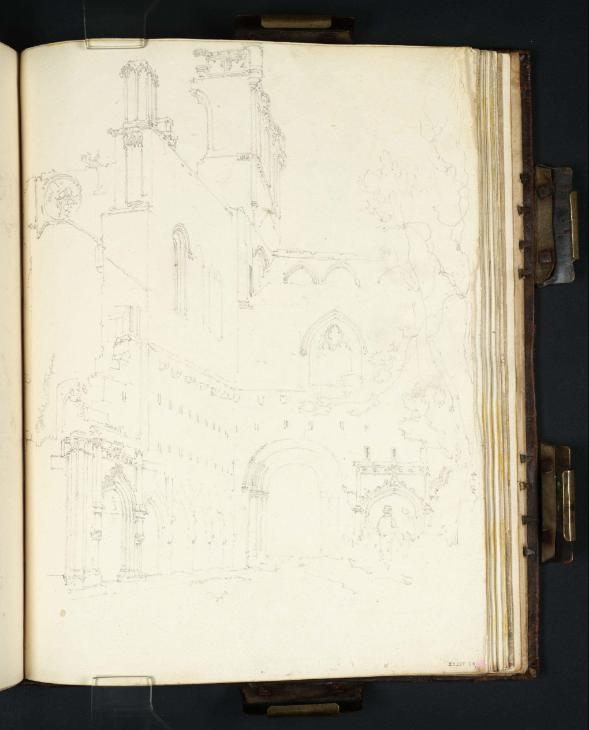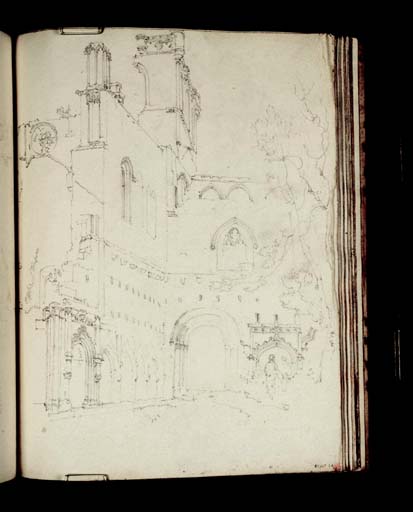Joseph Mallord William Turner Melrose Abbey: The North Transept and Nave Seen from the Cloister 1797
Image 1 of 2
Joseph Mallord William Turner,
Melrose Abbey: The North Transept and Nave Seen from the Cloister
1797
Joseph Mallord William Turner 1775–1851
Folio 64 Recto:
Melrose Abbey: The North Transept and Nave Seen from the Cloister 1797
D00969
Turner Bequest XXXIV 60
Turner Bequest XXXIV 60
Pencil on white wove paper, 270 x 210 mm
Blind-stamped with Turner Bequest monogram towards bottom right
Inscribed by John Ruskin in red ink ‘60’ bottom right
Stamped in black ‘XXXIV 60’ bottom right
Blind-stamped with Turner Bequest monogram towards bottom right
Inscribed by John Ruskin in red ink ‘60’ bottom right
Stamped in black ‘XXXIV 60’ bottom right
Accepted by the nation as part of the Turner Bequest 1856
References
1909
A.J. Finberg, A Complete Inventory of the Drawings of the Turner Bequest, London 1909, vol.I, p.72, XXXIV 60, as ‘Melrose Abbey; interior’.
1996
David Hill, Turner in the North: A Tour through Derbyshire, Yorkshire, Durham, Northumberland, the Scottish Borders, the Lake District, Lancashire and Lincolnshire in the Year 1797, New Haven and London 1996, pp.95, 192.
Melrose was the first Cistercian house in Scotland, founded in 1136 as successor to a seventh-century community at Old Melrose. After severe damage by the English in 1385 the whole abbey was sumptuously rebuilt, fell into ruin after the Dissolution and became in the eighteenth century one of the best-known Picturesque and Romantic medieval sites in Britain, thanks in large part to Sir Walter Scott (1771–1832) who came to live within sight of the abbey in 1811 and built his famous neo-Gothic home, Abbotsford, there from 1817. Turner was to revisit Melrose in Scott’s company in the 1830s, but his first visit cannot have been prompted by any such association since Scott’s poetry, which included references to the famous abbatial sites of the Border country that quickly gripped the imagination of the British public, did not appear in print until the turn of the century.
Turner made two detailed studies of the interior of the ruins, this one and another on a page of the Tweed and Lakes sketchbook (Tate D01019; Turner Bequest XXXV 16). Equally informative drawings of the exterior are on the next page, folio 65 recto (D00970; Turner Bequest XXXIV 61), and on Tate D40551 and D01020 (Turner Bequest XXXIV 17, 18) of the Tweed and Lakes book. This sequence of studies provides evidence that he was impressed both by the grandeur of the site and by the beauty of the ruins, but he did not make a finished view in the 1790s. He illustrated lines from Scott’s Lay of the Last Minstrel (Sterling and Francine Clark Art Institute, Williamstown, Massachusetts)1 in the series of drawings that he made for Walter Fawkes in the early 1820s (see note to folio 61 recto; D00966; Turner Bequest XXXIV 57), showing the west window by moonlight. He returned to the spot when collecting material for the complete works of Scott in the early 1830s: a panoramic view of Melrose and the Tweed (National Gallery of Scotland)2 was engraved by William Miller in 1833 as frontispiece to volume VI of the Poetical Works (Tate impression: T05142).
Verso:
Blank; stamped in brown ink with Turner Bequest monogram.
Andrew Wilton
January 2013
How to cite
Andrew Wilton, ‘Melrose Abbey: The North Transept and Nave Seen from the Cloister 1797 by Joseph Mallord William Turner’, catalogue entry, January 2013, in David Blayney Brown (ed.), J.M.W. Turner: Sketchbooks, Drawings and Watercolours, Tate Research Publication, November 2014, https://www


